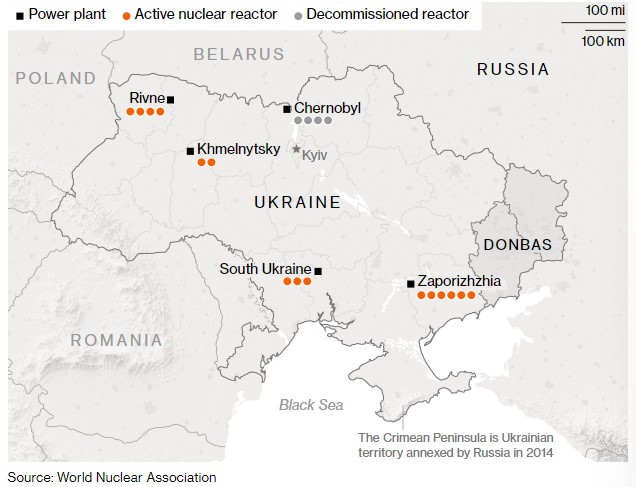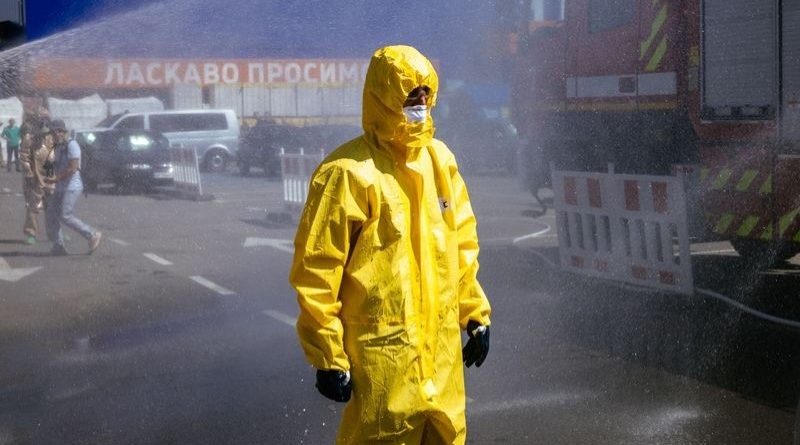Putin Can Be Pressured to Pull Troops From Ukraine Nuclear Plant
By Adm. James Stavridis, dean emeritus of The Fletcher School of Law and Diplomacy at Tufts University
The Russian president is using control of Zaporizhzhia to threaten Europe and hamper Ukraine’s troops. Here’s how to end the occupation.
Two decades ago, I spent more than two years sleeping a few decks above eight nuclear reactors onboard the Enterprise, the US Navy’s oldest nuclear-powered aircraft carrier. I was the rear admiral in command of the Enterprise’s strike group, and “broke my flag” and sailed to a long combat deployment in the Middle East to support the Iraq and Afghanistan wars.
I didn’t lose much sleep thinking about those reactors, because I knew how professional and meticulous the Navy was about operating them: All US submarines and carriers use nuclear propulsion. I spent a fair amount of time with our engineers and learned a great deal about the advantages and dangers of atomic power.
Today, I am losing sleep about the situation in Ukraine, where Russian President Vladimir Putin’s troops are occupying Europe’s largest nuclear power plant at Zaporizhzhia. Putin is truly playing with fire, and much of Europe (and Russia as well) are at significant risk of a nuclear incident with terrible long-term consequences. What should the international community do?
Putin’s Dangerous Nuclear Game in Ukraine
Zaporizhzhia accounts for about 20% of the nation’s electricity

Russians have captured the entire nuclear complex in southeast Ukraine, and are doggedly holding on to it for three principal reasons. First, Putin sees the strategically located site, near the focus of Ukraine’s long-awaited offensive operations centered on the Kherson region, as a kind of sanctuary from which his forces can stage attacks. He believes that the Ukrainians won’t bombard the site given the risks of a radiation release.
Second, Putin is using the situation to intimidate the Europeans, in essence threatening a nuclear disaster like the Chernobyl crisis in 1986. Finally, he wants to be able to cut off Ukraine’s power grid — Zaporizhzhia supplies a staggering 20% of the country’s electricity.
We don’t have to imagine what a radiation release could look like. We need only look back to Chernobyl, which was caused by structural and training failures. The effects were felt most directly in Ukraine, but significant radiation ended up in Belarus to the north and into Russia itself. Predicting deaths attributed to such a radiation event is difficult, but most sources believe thousands ended up dead or with severe health consequences, notably cancers. The costs of remediation approached $100 billion with over 330,000 evacuees.
More recently, in 2011, an earthquake and tsunami struck the Fukushima Daiichi nuclear power plant in Japan. The reactor failure and nuclear release was given the International Atomic Energy Agency’s most severe rating, level 7, equaling only Chernobyl. Despite massive civilian response and plenty of international assistance (including teams from the US Navy), thousands of people were affected, with over 150,000 evacuated.
Now imagine if there had been a war going on at either Chernobyl in 1986 or Fukushima in 2011. The toll of deaths and property costs would have been far higher, given the additional difficulty of getting relief forces and radiation mitigation solutions into the plants.
In the case of Zaporizhzhia, there are several paths to disaster. First would be a failure to operate the plant safely. Ukrainian workers are heroically keeping the plant functioning, under the guns of Russian occupiers. An error on their part — hardly unlikely given the pressures on site — could cause a cooling crisis leading to a meltdown.
Another obvious concern, one that nearly occurred just days ago, would be combat that knocks out the cooling system, which requires electricity, and destroys the backup diesel generators (which could also run out of fuel).
Finally, artillery fire could hit the containers of spent uranium on the site, creating a more localized but still dangerous radiation release. While we are assured that a full nuclear detonation could not occur, the long-term risks to people and infrastructure are obvious. Zaporizhzhia is truly a ticking time bomb.
What can be done to avoid a Chernobyl-type disaster? Most importantly, the international community must insist on a comprehensive inspection of the reactor. This is a mission for the IAEA, ably led by Argentine diplomat Rafael Grossi, which has a team on its way to the site this week.
(Less urgently, this type of mission should be considered elsewhere — there are more than 440 nuclear power plants worldwide, some in regions that are politically unstable or vulnerable to natural disaster.)
The next step is complicated but critical: demilitarize the Zaporizhzhia plant and the surrounding area. Any nuclear operation in a combat zone must be regarded under international law similarly to a medical facility or religious center — a no-strike/no-occupy zone. Russia should be pressured to turn the plant over to an international mission led by the United Nations and staffed by the IAEA. Logistical support could be provided by a neutral country, perhaps India, which operates more than 20 reactors.
Convincing Russia to do this will be difficult, but additional pressure could be brought to bear by further condemnation in the UN General Assembly; by the North Atlantic Treaty Organization returning to the idea of a no-fly zone, at least one limited to the area around the nuclear plant; or by increased economic punishment, including global secondary sanctions on Russian energy sales.
Recent negotiations between Russia and Ukraine, organized by Turkey and the UN, restarted grain shipments out of Ukraine’s Black Sea ports to help ensure that food scarcity did not lead to global unrest. Avoiding the potential catastrophe of a massive nuclear radiation release is at least as important.
This piece was republished from Bloomberg.

